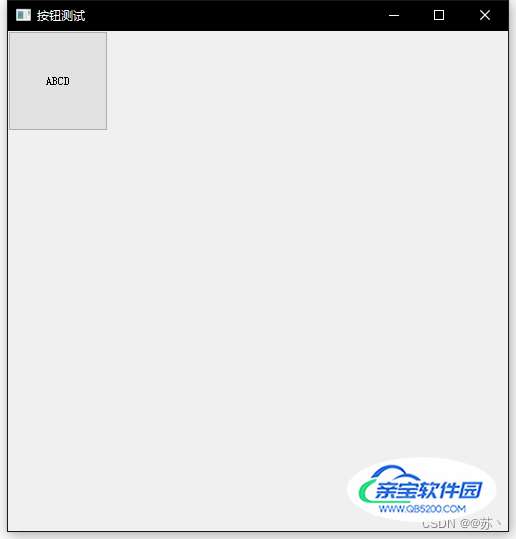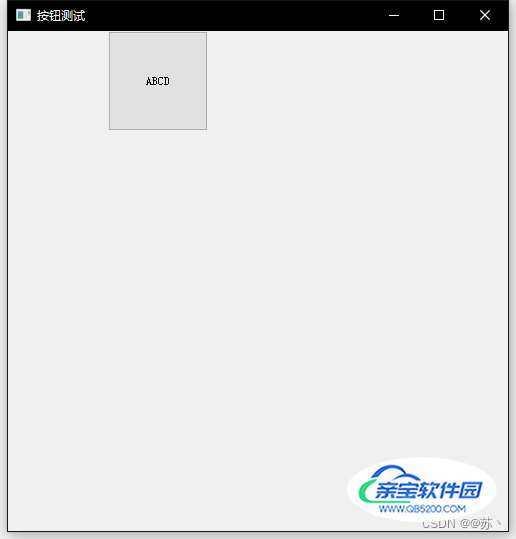Python PyQt拖动控件对齐到网格的方法步骤
@苏丶 人气:0实现如下需求:
在PyQt界面上有一个控件,实现其可任意拖动,且鼠标释放时自动对齐到网格。
1.控件任意拖动并对齐到网格
如下按钮(尺寸100×100),可任意拖动,释放时对齐到网格(网格尺寸100×100)


首先给出代码
from PyQt5.QtWidgets import QPushButton, QMainWindow, QApplication
class Button(QPushButton):
def __init__(self, parent=None):
super().__init__(parent)
self.resize(100, 100)
self.pos1 = 0 # 用于拖动时的鼠标位置初始值
def mousePressEvent(self, QMouseEvent):
self.pos1 = QMouseEvent.screenPos()
def mouseReleaseEvent(self, QMouseEvent) -> None:
fx, fy = self.frameGeometry().x(), self.frameGeometry().y() # 相对父控件坐标
tx_index, ty_index = fx // 100 if fx > 99 else 0, fy // 100 if fy > 99 else 0
# 移动到网格上
self.mymove(tx_index, ty_index)
def mouseMoveEvent(self, QMouseEvent):
pos2 = QMouseEvent.screenPos()
tx = int(self.frameGeometry().x() + pos2.x() - self.pos1.x())
ty = int(self.frameGeometry().y() + pos2.y() - self.pos1.y())
self.move(tx, ty)
self.pos1 = pos2
def mymove(self, tx_index, ty_index):
self.move(tx_index * 100, ty_index * 100)
class MainWindow(QMainWindow):
def __init__(self):
super().__init__()
self.setWindowTitle('按钮测试')
self.resize(500, 500)
self.btn = Button(self)
self.btn.setText('ABCD')
if __name__ == "__main__":
import sys
app = QApplication(sys.argv)
mw = MainWindow()
mw.show()
sys.exit(app.exec_())
这里自定义Button类继承QPushButton类,因为我们需要重写鼠标移动的方法来实现所需功能。
要实现任意拖动,按钮必须跟随鼠标,于是我们重写mousePressEvent方法和mouseMoveEvent方法。
- 当我们按下鼠标时,触发mousePress事件,记录此刻光标位置;
- 当光标拖动时触发mouseMove事件,获取当前光标位置,计算与之前位置的x和y的差值,然后加到按钮的相对坐标上,获得按钮需要移动到的位置坐标;
- 调用move方法移动按钮;
- 更新pos1即按钮位置;
- 只要光标移动,就会触发mouseMove事件,就会不断移动按钮与更新按钮位置,在视觉上按钮就是在跟着光标任意拖动。
要实现鼠标释放时对齐到网格,需要重写mouseReleaseEvent方法,用来响应鼠标释放动作。
- 当鼠标释放时,立即读取按钮的当前相对坐标;
- 将按钮的坐标除以100用来获取其在网格上的位置,如果坐标小于0应令其等于0,同时0-99的坐标除以100也等于0,于是只要小于99就等于0;
- 然后调用自定义的mymove方法,在这个方法中,将网格位置换算到相对坐标,再调用move方法使其移动到网格。
2.进阶:双击控件使其移动到其他网格
移动并对齐到网格的功能已经在上一部分实现了,这里需要实现鼠标双击动作,首先给出代码
from PyQt5.QtWidgets import QPushButton, QMainWindow, QApplication
from PyQt5.QtCore import Qt
class Button(QPushButton):
def __init__(self, parent=None):
super().__init__(parent)
self.resize(100, 100)
self.pos1 = 0 # 用于拖动时的鼠标位置初始值
self.x_index, self.y_index = 0, 0 # 记录按钮在网格上的位置
def mousePressEvent(self, QMouseEvent):
if QMouseEvent.buttons() == Qt.LeftButton:
print('左键按下')
self.pos1 = QMouseEvent.screenPos()
elif QMouseEvent.buttons() == Qt.RightButton:
print('右键按下')
self.pos1 = QMouseEvent.screenPos()
def mouseReleaseEvent(self, QMouseEvent) -> None:
print('鼠标释放')
fx, fy = self.frameGeometry().x(), self.frameGeometry().y() # 相对父控件坐标
tx_index, ty_index = fx // 100 if fx > 99 else 0, fy // 100 if fy > 99 else 0
# 移动到网格上
self.x_index, self.y_index = tx_index, ty_index
self.mymove(tx_index, ty_index)
def mouseDoubleClickEvent(self, QMouseEvent):
if QMouseEvent.buttons() == Qt.LeftButton:
print('左键双击')
self.x_index += 1
self.y_index += 1
self.mymove(self.x_index, self.y_index)
elif QMouseEvent.buttons() == Qt.RightButton:
print('右键双击')
def mouseMoveEvent(self, QMouseEvent):
if QMouseEvent.buttons() == Qt.LeftButton:
pos2 = QMouseEvent.screenPos()
tx = int(self.frameGeometry().x() + pos2.x() - self.pos1.x())
ty = int(self.frameGeometry().y() + pos2.y() - self.pos1.y())
self.move(tx, ty)
self.pos1 = pos2
def mymove(self, tx_index, ty_index):
self.move(tx_index * 100, ty_index * 100)
print(f'按钮移动到({tx_index}, {ty_index})')
class MainWindow(QMainWindow):
def __init__(self):
super().__init__()
self.setWindowTitle('按钮测试')
self.resize(500, 500)
self.btn = Button(self)
self.btn.setText('ABCD')
if __name__ == "__main__":
import sys
app = QApplication(sys.argv)
mw = MainWindow()
mw.show()
sys.exit(app.exec_())在这里多了一些实例属性,如self.x_index, self.y_index用来记录按钮在网格上的位置。
要实现双击动作,必须重写mouseDoubleClickEvent方法,在mouseDoubleClickEvent方法中,我们首先将self.x_index, self.y_index进行修改,以更改按钮要移动到的位置,然后调用mymove方法进行移动。
此外,代码还进行了左键与右键的判断,当左键进行操作时,按钮可以更改位置,右键操作时不可更改。
总结
加载全部内容